What is Glif?
Working Examples
Introduction
In the fast-paced world of artificial intelligence, a new platform is gaining attention by making AI-powered content creation more accessible. Introducing Glif — a playful yet robust low-code platform that empowers users to create and share compact AI media generators, known as “glifs.” These glifs are transforming how we interact with AI, allowing everyone — from curious newcomers to experienced developers — to tap into advanced AI models for creative expression, problem-solving, and innovation.
In this article, we’ll take a deep dive into Glif’s ecosystem, highlighting its distinctive features through three hands-on examples. You’ll learn how to use an existing glif for image generation, build your own custom glif from scratch, and utilise the Glif browser extension to enhance web content. By the end, you’ll have a thorough understanding of Glif’s potential and how it’s ushering in a new era of accessible, AI-driven creativity.
What is Glif?
At its core, Glif is a revolutionary platform that bridges the gap between complex AI technologies and everyday users. It’s a space where anyone can create, run, and share small AI-powered applications called “glifs.” These glifs are essentially miniature programs that take various inputs — such as text, images, or simple button clicks — and produce outputs like generated images, videos, or text, all powered by sophisticated AI models.
What sets Glif apart is its intuitive, block-based interface. Users can construct glifs by connecting different functional blocks, much like assembling a digital puzzle. These blocks represent various AI capabilities, including text generation, image creation, and data processing. This visual approach to AI application development makes it accessible to those without coding experience while still offering enough depth to engage seasoned developers.
Glif’s ecosystem extends beyond just creation. It’s a vibrant community where users can explore glifs created by others, remix existing glifs to suit their needs, and share their own creations. This collaborative environment fosters innovation and creativity, allowing ideas to evolve and spread rapidly. Whether you’re looking to generate AI art, create interactive storytelling experiences, or develop practical tools for data analysis, Glif provides a flexible, user-friendly platform to bring your ideas to life.
Getting Started with Glif
Glif is designed to be user-friendly, allowing anyone to dive into AI-powered content creation within minutes. This quick-start guide will walk you through the process of using an existing glif, giving you a taste of what the platform can do.
Steps to Use Your First Glif
- Navigate: Go to https://glif.app/glifs/featured to see a list of featured glifs.
- Browse: Scroll through the featured glifs and find one that catches your interest.
- Select: Click on your chosen glif to open its dedicated page.
- Input: Provide the necessary information as prompted (text, image, or selections).
- Run: Click the “Run This Glif” button to activate the AI process.
- Wait: Allow a few seconds for the AI to generate the output.
- View: Examine the generated result (image, text, video, or other media).
- Save/Share: If you’re satisfied with the result, use the provided options to save or share it.
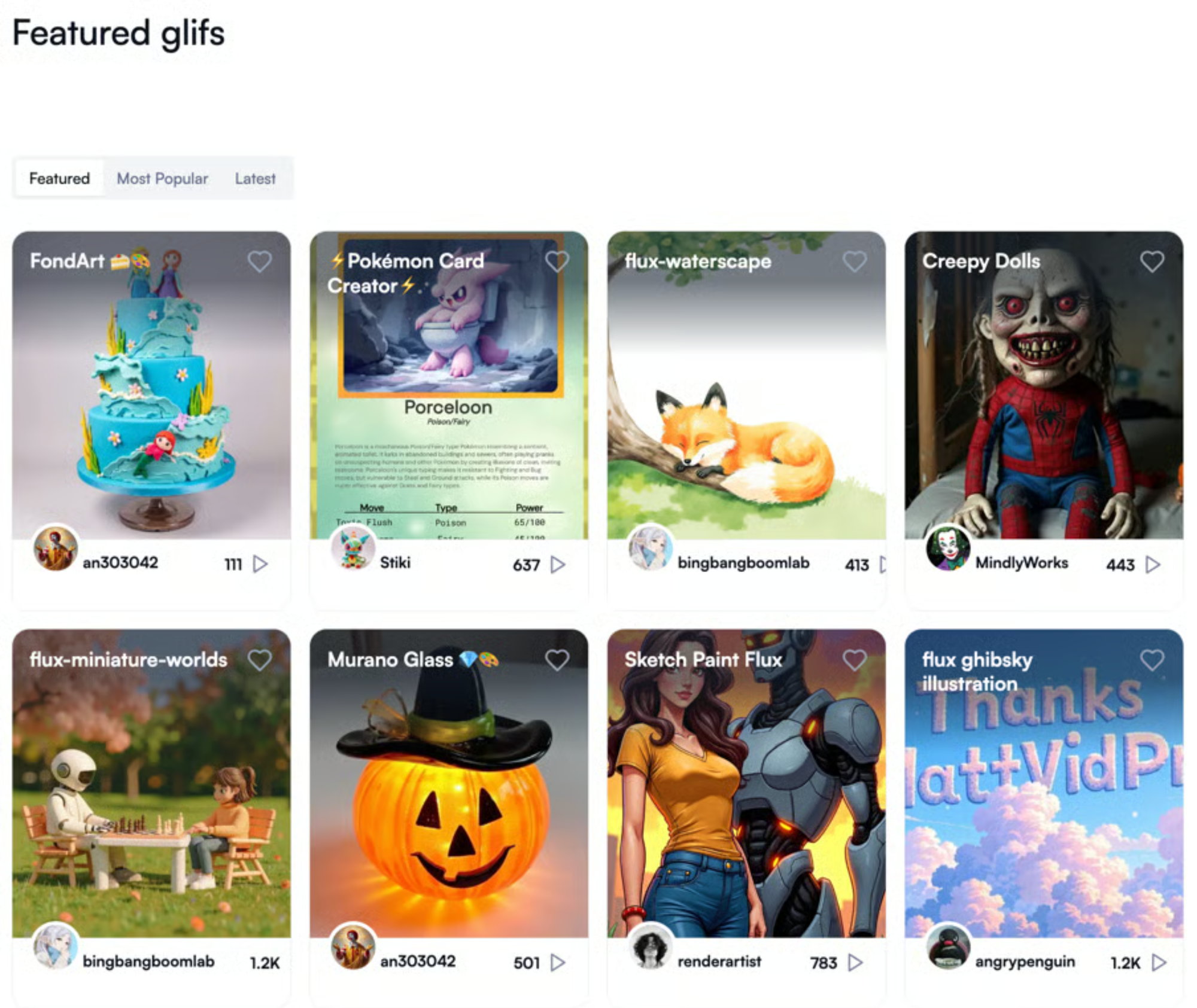

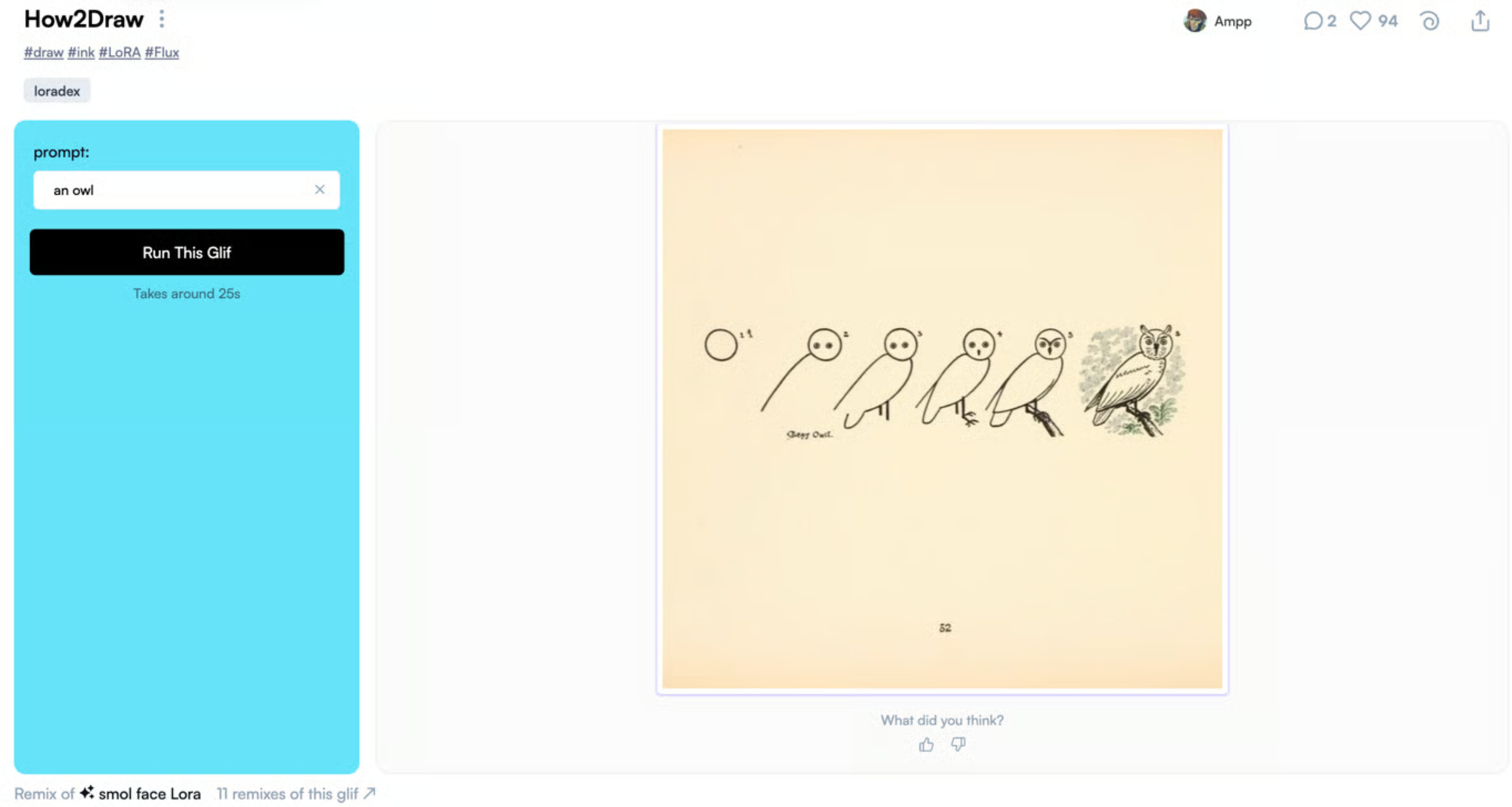
Working Example 1: Building Your Own Glif
In this example, we’ll create a basic glif that generates minimalistic line drawings based on user input. This glif will demonstrate the fundamental process of building your own AI-powered tool on the Glif platform. We’ll use a text input block connected to an image generator block, with a customised prompt template.
Steps to Build Your Own Glif
- Navigate: Go to https://glif.app and click on the “Build” tab.
- Add Generator: Drag an “Image Generator” block onto your canvas.
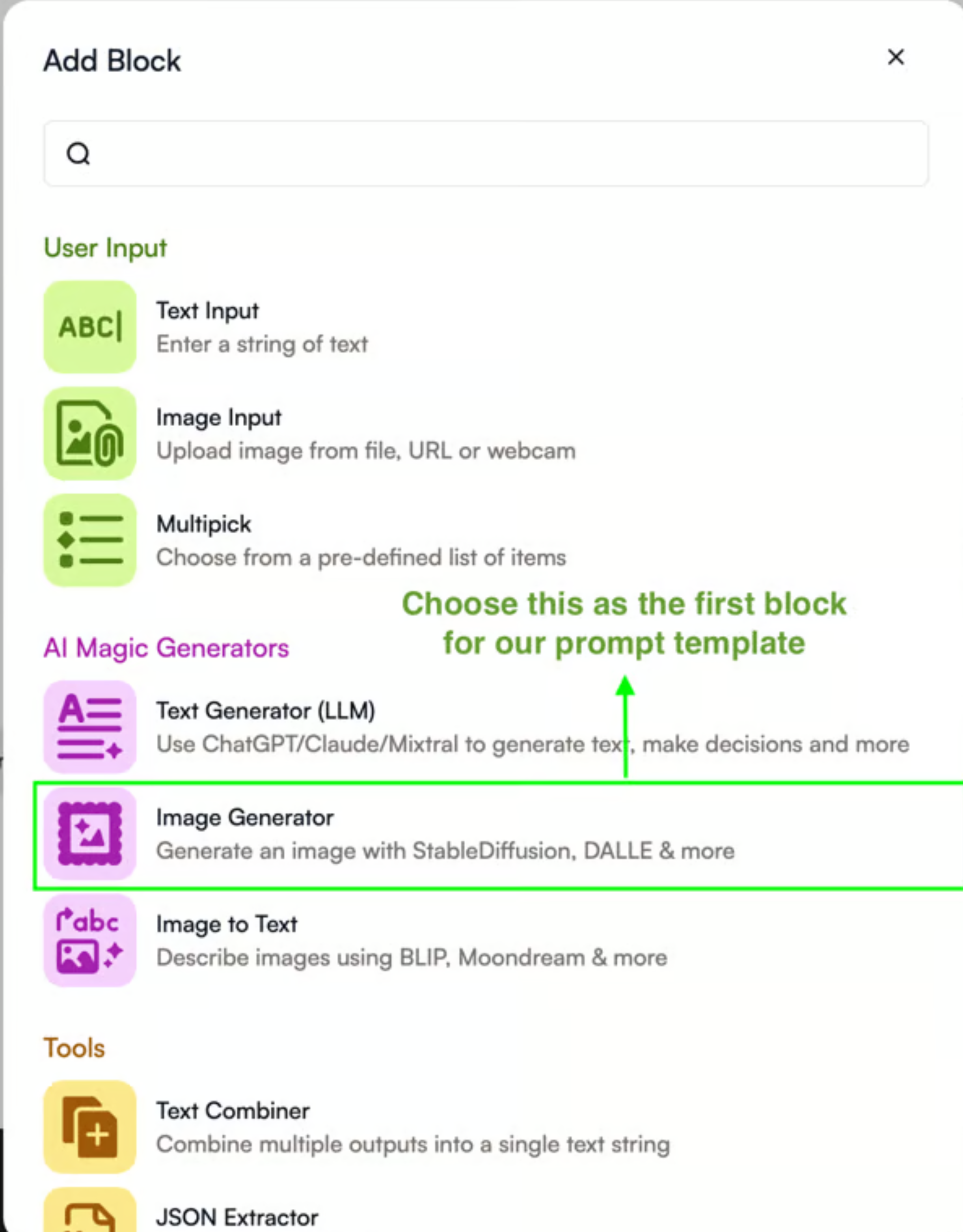
3. Configure Generator: In the Image Generator block settings:
- Choose your preferred AI model (e.g., Stable Diffusion or Flux)
- Set the image size (e.g., 1024x1024)
4. Craft Initial Prompt Template: In the prompt field of the Image Generator block, paste a test version of your template which sets the style of your generated output
Create a simple, minimalistic line drawing of a cat. Use clean, smooth lines with no shading or intricate details. The composition should be uncluttered and focus on the essence of the object, capturing its core features in a clear and elegant way. The background should be blank, allowing the lines to stand out. The style should feel light, balanced, and minimal, evoking a sense of simplicity and calm.
5. Test Generator: Click the “Run this Glif” button to test your Image Generator with this prompt.
6. Refine Prompt: Adjust the prompt as needed based on the test results until you’re satisfied with the output style.
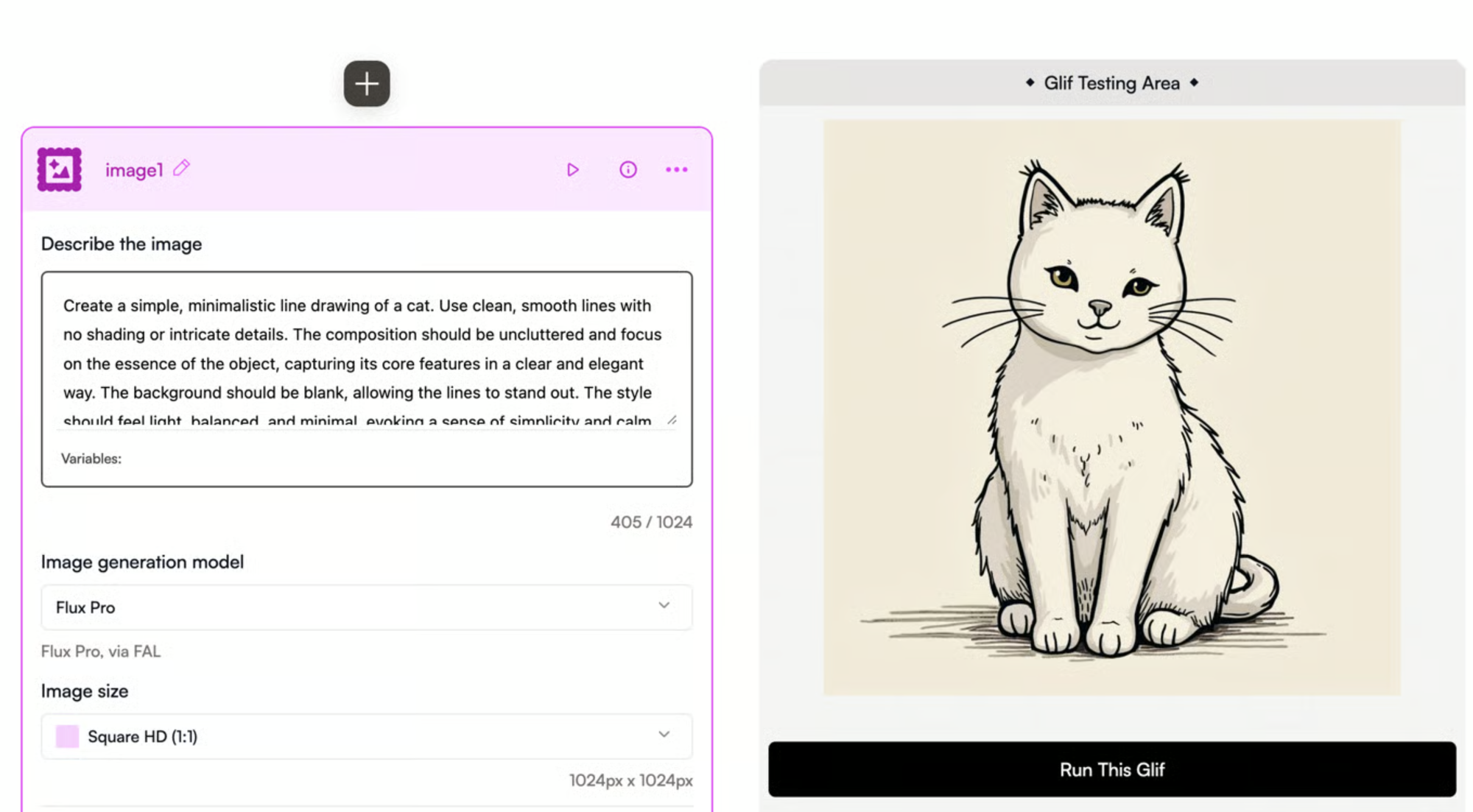
7. Add Input: Once satisfied with the image style, drag a “Text Input” block onto your canvas.
8. Configure Input: Set the label for your text input (e.g., “Object to Draw”).
9. Connect Blocks: Link the output of the Text Input block to the Image Generator block.
10. Update Prompt: In the Image Generator block, replace the specific object in your prompt with {input1}:
Create a simple, minimalistic line drawing of {input1}. Use clean, smooth lines with no shading or intricate details. The composition should be uncluttered and focus on the essence of the object, capturing its core features in a clear and elegant way. The background should be blank, allowing the lines to stand out. The style should feel light, balanced, and minimal, evoking a sense of simplicity and calm
11. Final Test: Use the “Preview” mode again to test your complete glif with different text inputs.
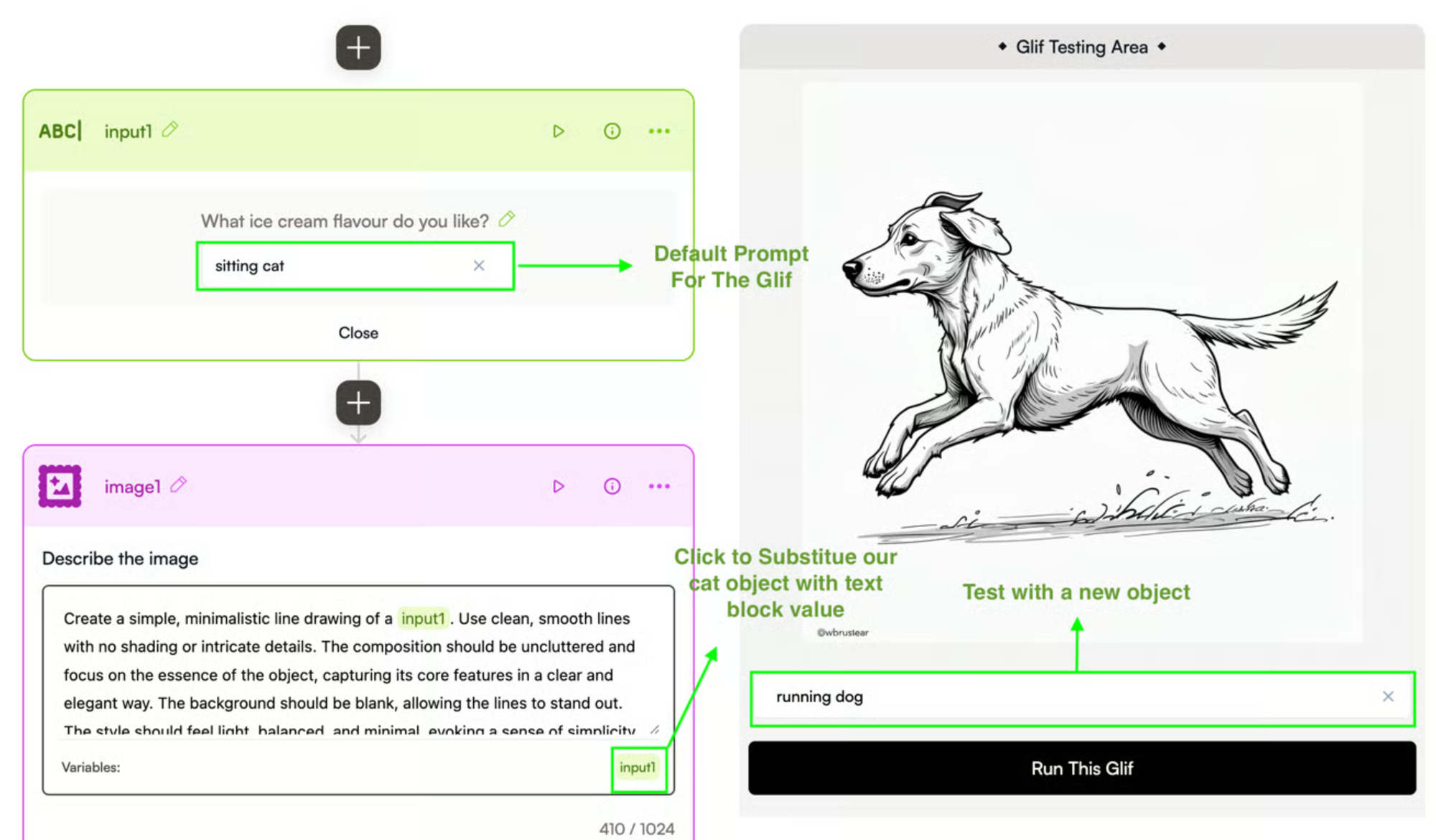
12. Publish: Once satisfied with the results, click “Publish” to make your glif available to others.

This simple glif takes a user’s text input describing an object and generates a minimalistic line drawing of that object. The key here is the prompt template, which instructs the AI to create a specific style of image regardless of the input. The {input1} in the prompt is automatically replaced with the user’s input text. This approach allows for a consistent style while enabling variety in the subjects drawn. Users of your glif can now generate minimalistic line drawings of any object they can describe in words.
Working Example 2: Using the Glif Browser Extension
The Glif Browser Extension, also known as “Glif It!”, is a powerful tool that allows you to remix any image you find on the web using Glif’s AI capabilities. This extension bridges the gap between web browsing and AI-powered image manipulation, enabling you to transform images instantly without leaving your browser.
Steps to Use the Glif Browser Extension
- Install: Go to the Chrome Web Store and add the Glif Browser Extension to your Chrome browser.
- Navigate: Browse to any webpage containing images you’d like to remix.
- Select: Right-click on an image of your choice.
- Activate: Choose “Glif it!” from the context menu that appears.
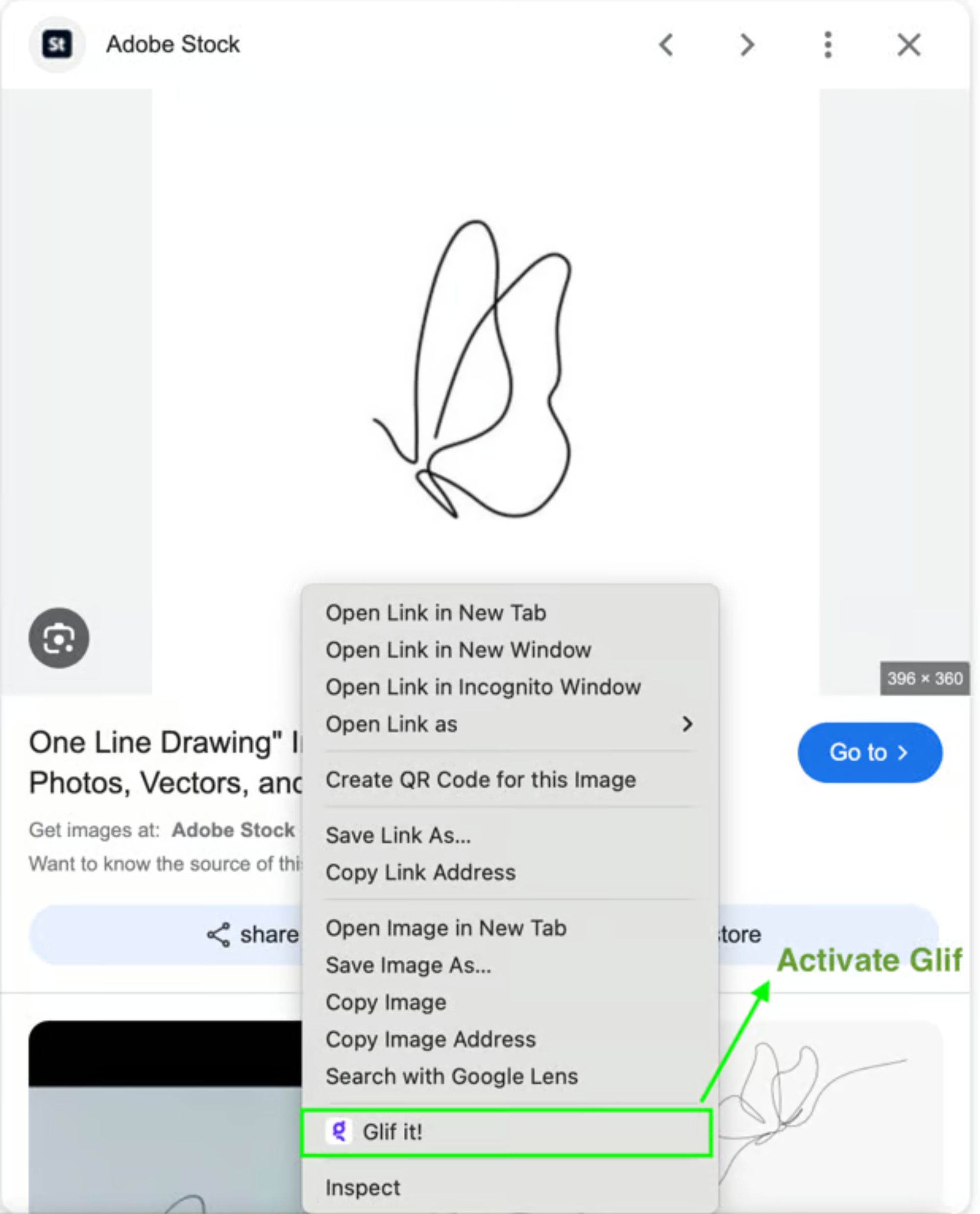
5. Choose Effect: In the Glif extension popup, select an effect from the dropdown menu.
6. Input Prompt: Enter your own prompt or click “✨ Generate prompt for me” for an AI-generated example.
7. Generate: Click the “Glif it!” button to start the remixing process.

8. View: After about 30 seconds, your remixed image will appear in the gallery below.

9. Experiment: Try the extension on different images and with various effects and prompts.
The Glif Browser Extension seamlessly integrates AI-powered image manipulation into web browsing. It allows users to transform any online image using Glif’s AI capabilities without leaving their browser. By selecting an image, choosing an effect, and inputting a prompt, users can create unique, AI-generated variations of web content. This tool democratises AI creativity, making it accessible to anyone browsing the internet, from casual users to professional content creators. The extension’s simplicity and integration with web browsing workflow exemplify how AI can enhance everyday digital experiences, turning the entire web into a playground for AI-assisted creativity.
Potential Applications
Glif’s versatility opens up a wide range of potential applications across various industries. In education, teachers can create interactive learning materials, visualising complex concepts or generating custom illustrations for lessons. Marketers can leverage Glif for rapid prototyping of ad concepts, creating personalised content, or developing unique social media assets. Writers and storytellers can use it to generate visual accompaniments to their narratives, enhancing engagement and bringing their stories to life.
In the creative industries, Glif serves as a powerful ideation tool. Designers can quickly iterate on concepts, while artists can explore new styles and techniques. For software developers, Glif’s API integration allows for the incorporation of AI-generated content into applications, websites, and games. Additionally, Glif’s accessibility makes it valuable for personal projects, enabling individuals to create custom artwork, design personalised gifts, or enhance their digital communication with AI-generated visuals. The platform’s potential extends to any field where visual creativity and rapid content generation are valued.
Conclusion
Glif represents a significant leap forward in democratising AI-powered content creation. By combining user-friendly interfaces with powerful AI models, it enables users of all skill levels to harness the potential of artificial intelligence for creative expression and problem-solving. Through our exploration of using existing glifs, building custom ones, and leveraging the browser extension, we’ve seen how Glif can transform ideas into visual reality with unprecedented ease. As AI technology continues to evolve, platforms like Glif are poised to play a crucial role in shaping how we interact with and utilise AI in our daily lives, opening up new possibilities for innovation across various fields and empowering individuals to bring their creative visions to life.
References
Catch the latest version of this article over on Medium.com. Hit the button below to join our readers there.



















